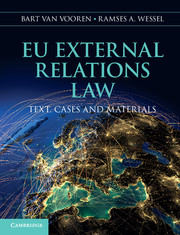Book contents
- Frontmatter
- Contents
- Table of cases
- Table of instruments and legislation
- Preface
- Acknowledgements
- List of abbreviations
- 1 The EU as a global legal actor
- 2 Instruments of EU external action
- 3 Existence of EU external competence
- 4 Nature of EU external competence
- 5 Scope and choice of EU external competence
- 6 The duty of cooperation
- 7 EU law and international law
- 8 The EU and international institutions
- 9 Common Commercial Policy
- 10 EU development policy
- 11 Common Foreign and Security Policy
- 12 Common Security and Defence Policy
- 13 The external dimension of the internal energy market
- 14 The external dimension of freedom, security and justice
- 15 The EU and its neighbours
- Index
- References
5 - Scope and choice of EU external competence
- Frontmatter
- Contents
- Table of cases
- Table of instruments and legislation
- Preface
- Acknowledgements
- List of abbreviations
- 1 The EU as a global legal actor
- 2 Instruments of EU external action
- 3 Existence of EU external competence
- 4 Nature of EU external competence
- 5 Scope and choice of EU external competence
- 6 The duty of cooperation
- 7 EU law and international law
- 8 The EU and international institutions
- 9 Common Commercial Policy
- 10 EU development policy
- 11 Common Foreign and Security Policy
- 12 Common Security and Defence Policy
- 13 The external dimension of the internal energy market
- 14 The external dimension of freedom, security and justice
- 15 The EU and its neighbours
- Index
- References
Summary
Central issues
Once we have established that the EU has a competence to act (existence of competence), and know the impact of this competence on the Member States’ capacity to act in the same field (nature of competence), we must also examine the scope (width, or ambit) of the competence which exists, and we may need to make a choice between different legal bases if EU international action may be based on more than one Treaty article.
Establishing the appropriate legal basis entails an assessment of the exact scope of EU powers, and classification of the measure as falling within that scope. Given the different procedures tied to competence-conferring provisions, and the different nature as shared or exclusive, the choice of legal basis is a highly politicized and sometimes controversial process.
In scope and choice of EU competence, we can distinguish between a vertical situation between the Member States and the Union, and a horizontal intra-EU situation. From a vertical perspective, the question is, can a given external measure be undertaken at all by the Union on the basis of the powers which have been established to exist? The horizontal situation concerns the question, if a measure does indeed fall within the powers of the Union, and if a number of candidate legal bases exist, which is the correct legal basis?
The legal methods to establish the scope of Treaty provisions and choose the correct legal basis provide a central role to the Court in arbitrating competing intra-EU power relations. To avoid subjective views deciding the choice of competence, the Court developed an ‘objective’ legal method to ensure legal certainty for the institutions and Member States: the appropriate legal basis, or centre-of-gravity test.
- Type
- Chapter
- Information
- EU External Relations LawText, Cases and Materials, pp. 138 - 188Publisher: Cambridge University PressPrint publication year: 2014



